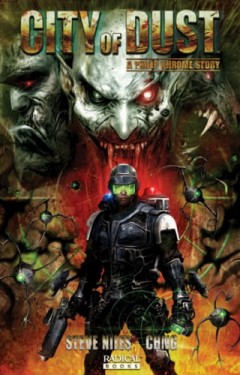Brilliant art coupled with a clever story make Steve Niles’s graphic novel City of Dust an instant sci-fi horror classic. Niles, who also wrote graphic novel 30 Days of Night and the first draft of its film adaptation, loops good cops, bad laws, prostitutes, and mechanical nightmares into a deeper story about imagination and thought crimes. The story takes place within a metropolis setting where your socio-economic status, as well as your physical safety, is dependent on how many stories you are above the ground. Cops roam the lower parts of this vertical city looking for looking for anything resembling imagination-paraphernalia, classified as anything that might evoke imaginative thinking or thought crimes. All media is banned in the year 2166: books, music, movies, religious art, even religion itself.
Khrome, leading character and cop convinced something is wrong with the system, was persuaded as a child to have his father arrested and imprisoned for life simply for reading him children’s books. Years later Khrome does the arresting and the trials are conducted instantly via e-mail. The verdict for indulging in such imagination-paraphernalia…instant death. Later on in the story, Khrome becomes involved in a crime scene investigation where a children’s book is found on the scene of a mutilated, half-eaten corpse. Told to keep his distance until the fed’s arrival, Khrome can’t help but open this rectangular object and indulge. His actions are cause for alarm and Khrome finds himself involved in much more than police work.
Overall, City of Dust is your typical dark, sinister sci-fi horror graphic novel (though nothing close to the level of disturbia in Garth Ennis’ Crossed). It’s well-written and well-drawn with lots of political undertones dealing with authoritarianism and censorship, though the story feels slightly rushed at the end. The author’s well-structured plot seems to fall apart in a last minute sprint to finish the project within the remaining 10 pages of the book.















